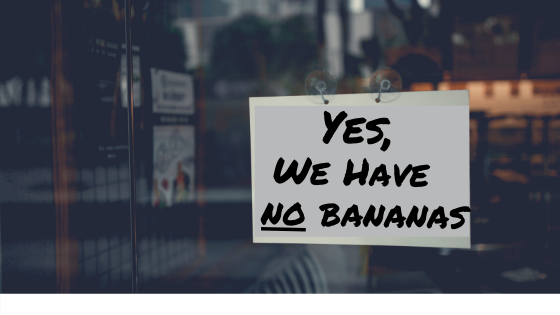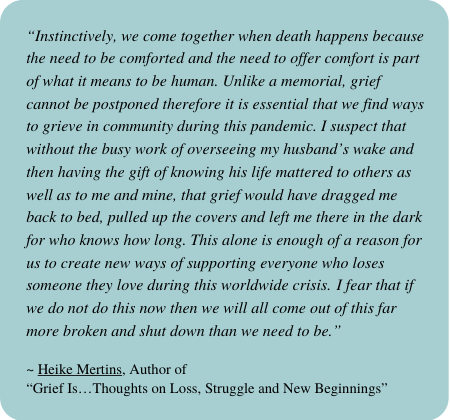
“We were beside ourselves to hear that there were bananas in town,” she said with a smile, “so my mother sent me on a special shopping trip.” She continued, “On the crowded bus, I imagined what the sweet, tropical fruit would taste like and envisioned how excited my little brother and sister would be when I arrived home with a yellow bunch of happiness. After standing in a cramped line for what seemed like forever, it was finally my turn. But by then, all the bananas were gone. And I cried, all the way home.”
It was 1945 when that first shipment of post-wartime bananas arrived in Glasgow. Dementia has not stolen the memory of that day, and my mother—now 85 years old, tells the story often.
Many of my parents’ childhood stories revolve around food—or rather, the lack thereof. “We were lucky to get an orange in our Christmas stocking,” they would remind me when I was a little girl. This likely explains my father’s need to always store a few pounds of butter in the freezer “just in case.” For years, their food supply was strictly rationed.
Their homeland, Scotland, endured more than 500 air raids during the course of the six-year war. Too young to fully comprehend the severity of the situation, they do vividly remember nights spent closely huddled together in air raid shelters. They were frightened, but their family, friends, and neighbours surrounded them, providing the physical and emotional comfort and security that community extends.
The beginning of their lives was hijacked by war. And now, it seems, so will be the end.
But this is a different kind of war. The invisible enemy doesn’t fly noisily above, but instead floats silently amongst us. The brave are not the soldiers who go off to fight, but the essential workers who risk their own health and safety to keep us healthy and safe. Trending hashtags include #stayhomestaysafe and #pandemicsurvivalplan, and phrases like “flattening the curve” and “social distancing” are now common, even amongst children.
Many of us are walking around in a cloud of bewilderment as we attempt to absorb the enormity of the crisis while reconciling the daily news updates and acclimating to the new normal that has been imposed on us. We miss our grandchildren and worry about our parents. Our fears extend beyond health as we watch unemployment soar and economic security plunge. Some of us long for company, and others yearn for just a moment of solitude. And we wish more than anything that we could go back to our old lives as we promise to never take them for granted.
This is grief. And all wars result in grief. But this war is redefining how we do grief. And perhaps the greatest tragedy of the current crisis is that not only are people dying away from their families, but families are grieving away from their people.
As this new reality sinks deeper into our bones, we grieve for the lives that have been lost and the lives we used to live. Physical distancing is a painful reminder of just how essential human connection and companionship are to our health and well-being. And when someone we love dies, there is perhaps no greater time that we need our community of support. Physical touch is the language we all understand, and it can reach a place that words alone just can’t. This war is robbing us of the rituals that help us mourn and depriving us of our basic human need to communicate empathy in its simplest form. It’s preventing us from saying goodbye and gathering to share tears, stories, and hugs.
End-of-life rituals and ceremonies help us by fostering connection, nurturing hope, and providing us with a place to go with our love and our grief. With traditional funeral gatherings no longer possible, some families may opt for live-streamed funerals, but others may find that the empty room and handful of masked attendees only illuminate their feelings of loneliness and isolation. Because of this, many may choose to postpone end-of-life ceremonies. But this leaves a chasm of time during which we must mourn alone. While waiting, we may need something to do and a place to go with our feelings of loss.
How to Bridge the Gap
Our current challenge is to find new and creative ways to connect people and their grief and, just as with funerals, there really is no “one-size-fits-all” solution. “Holding space” is what I consider to be my primary role as a celebrant. And although today’s virtual space may look and feel different from what we are familiar with, a custom-crafted, unique experience can be created to help families bridge the gap between where they are now and a future in-person memorial.
A community sharing circle can fill virtual space with stories, love, and grief. A daily ritual in which family and friends light a special candle at the same time until they can be reunited and light them together in the same space can create a circle of love and light that defies distance. Photos can be assembled for a video tribute that can be shared now on social media and again later at an in-person gathering. Memories and stories can be collected from friends and family in a scrapbook that can later be displayed at the memorial. The possibilities really are endless. These simple yet meaningful gestures can help families stay connected while filling space with ritual, stories, tears, and maybe even laughter.
They say the wounds of war never heal. I suppose time will tell, but I hope that’s not true. I do believe that the stories of war never end, and those stories are changing our future forever. All I know right now is that I ache for the day I can hug my parents again and squish my entire family around the dining room table with not an inch of elbowroom to spare.
I may never fully relate to my parents’ wartime stories, but last week I lined up outside a Toronto grocery store for what seemed like forever. Sporting my homemade mask and frightfully cautious of getting too close to another human being, I stood six feet from the people in front of and behind me. When it was finally my turn to enter, I carefully followed the arrows on the floor, efficiently steering my cart up and down the aisles, mindful not to touch anything I wasn’t prepared to buy. When I arrived at the produce section, I marvelled at the abundance of brightly displayed fruits and vegetables. And in the corner, I spied a giant mountain of yellow bunches of happiness.
Yes, they had bananas—lots and lots of bananas.
And I cried, all the way home.
* * *

AUTHOR: LINDA STUART
Linda Stuart is a Life-Cycle Celebrant/Officiant, Writer and Speaker located in Toronto, Ontario. Specializing in funerals and weddings, Linda’s passion is bringing stories to life through meaningful ceremonies.
You may also like: Are We Dead Wrong About Closure? ** When I Die, Please Do Something ** 10 Things I Wish You Knew About Funerals


Another beautifully written article Linda. These certainly are unprecedented times. You have a profound talent at delivering grieving alternatives straight from the heart.
Wishing you a bundle of bananas. xo
Let’s celebrate by sharing a banana when we are together again! xo
Well written and read Linda. I battled Costco in Lindsay this morning, over 60 ;). It was crazy…
Anyway a “bunch of bananas” to you, Dave and family.
Xox
Thank you, Linda, for your thoughtful reflection. I’m so happy you found bananas in this ‘twilight zone’ we are living in.